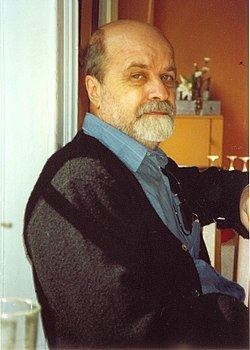Name Fedor Bogomolov | Role Mathematician | |
 | ||
Books Algebraic curves and one-dimensional fields | ||
Fedor bogomolov symmetric tensors and the geometry of subvarieties of p n
Fedor Alekseyevich Bogomolov (born 26 September 1946) (Фёдор Алексеевич Богомолов) is a Russian and American mathematician, known for his research in algebraic geometry and number theory. Bogomolov worked at Steklov Institute in Moscow before he became a professor at Courant Institute. He is most famous for his pioneering work on hyperkähler manifolds.
Contents
- Fedor bogomolov symmetric tensors and the geometry of subvarieties of p n
- Fedor Bogomolov
- Geometry of Khler manifolds
- Other works in algebraic geometry
- Other works in arithmetic geometry
- Later career
- References
Born in Moscow, Bogomolov graduated from Moscow State University, Faculty of Mechanics and Mathematics, and earned his doctorate ("candidate degree") in 1973, in Steklov Institute. His advisor was Sergei Novikov.
Fedor Bogomolov
Geometry of Kähler manifolds
Bogomolov's Ph. D. was entitled Compact Kähler varieties. In his early papers Bogomolov studied the manifolds which were later called Calabi–Yau and hyperkaehler. He proved a decomposition theorem, used for the classification of manifolds with trivial canonical class. It has been re-proven using the Calabi–Yau theorem and Berger's classification of Riemannian holonomies, and is foundational for modern string theory.
In the late 1970s and early 1980s Bogomolov studied the deformation theory for manifolds with trivial canonical class. He discovered what is now known as Bogomolov–Tian–Todorov theorem, proving the smoothness and un-obstructedness of the deformation space for hyperkaehler manifolds (in 1978 paper) and then extended this to all Calabi–Yau manifolds in the 1981 IHES preprint. Some years later, this theorem became the mathematical foundation for Mirror Symmetry.
While studying the deformation theory of hyperkaehler manifolds, Bogomolov discovered what is now known as Bogomolov–Beauville–Fujiki form on
Other works in algebraic geometry
Bogomolov's paper is "Holomorphic tensors and vector bundles on projective manifolds" which proves what is now known as Bogomolov–Miyaoka–Yau inequality and which proves that a stable bundle on a surface, restricted to a curve of sufficiently big degree, remains stable. In "Families of curves on a surface of general type", Bogomolov laid the foundations to the now popular approach to the theory of diophantine equations through geometry of hyperbolic manifolds and dynamical systems. In this paper Bogomolov proved that on any surface of general type with
Other works in arithmetic geometry
Bogomolov has contributed to several aspects of arithmetic geometry. He is the author of Bogomolov's conjecture about small points. Twenty years ago he contributed a proof (among many proofs) of the geometric Szpiro conjecture which appears to be the nearest to Shinichi Mochizuki's proof of the arithmetic Szpiro conjecture.
Later career
Bogomolov obtained his Habilitation (Russian "Dr. of Sciences") in 1983. In 1994, he emigrated to the U.S. and became a full professor at the Courant Institute. He is very active in algebraic geometry and number theory. From 2009 till March 2014 he served as the Editor-in-Chief of Central European Journal of Mathematics. Since 2014 he serves as the Editor-in-Chief of European Journal of Mathematics [1]. From 2010 he is the academic supervisor of the HSE Laboratory of algebraic geometry and its applications. Bogomolov has extensively contributed to the revival of Russian mathematics. Three major international conferences commemorating his 70th birthday were held in 2016: in Courant Institute, in University of Nottingham and in Higher School of Economics in Moscow.
